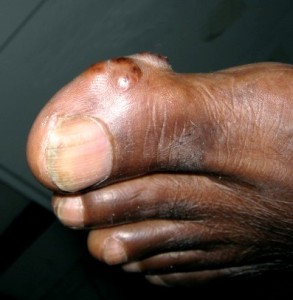Visit and Join the WeHeal Gout Community.
For more information, see: CDC | Mayo Clinic | Wikipedia

Gout is a rheumatic disease resulting from deposition of uric acid crystals (monosodium urate) in tissues and fluids within the body. This process is caused by an overproduction or under excretion of uric acid. Certain common medications, alcohol, and dietary foods are known to be contributory factors. Acute gout will typically manifest itself as an acutely red, hot, and swollen joint with excruciating pain. These acute gouty flare-ups respond well to treatment with oral anti-inflammatory medicines and may be prevented with medication and diet changes. Recurrent bouts of acute gout can lead to a degenerative form of chronic arthritis called gouty arthritis.
I. Background
• Gout is an ancient and common form of inflammatory arthritis, and is the most common inflammatory arthritis among men. Gout may remit for long periods, followed by flares for days to weeks, or can become chronic.
• Gout is caused by an uncontrolled metabolic disorder, hyperuricemia, which leads to the deposition of monosodium urate crystals in tissue. Hyperuricemia means too much uric acid in the blood. Uric acid is a metabolic product resulting from the metabolism of purines (found in many foods and in human tissue).
• Hyperuricemia is caused by an imbalance in the production and excretion of urate, i.e., overproduction, underexcretion or both.
• Hyperuricemia is not the same as gout. Asymptomatic hyperuricemia does not need to be treated.
• Risk factors for gout include being overweight or obese, having hypertension, alcohol intake (beer and spirits more than wine), diuretic use, a diet rich in meat and seafood, and poor kidney function.
• Weight loss lowers the risk for gout.
• Gout can be viewed in four stages: ◦Asymptomatic tissue deposition occurs when people have no overt symptoms of gout, but do have hyperuricemia and the asymptomatic deposition of crystals in tissues. The deposition of crystals, however, is causing damage.
Acute flares occur when urate crystals in the joint(s) cause acute inflammation. A flare is characterized by pain, redness, swelling, and warmth lasting days to weeks. Pain may be mild or excruciating. Most initial attacks occur in lower extremities. The typical presentation in the metatarsophalageal joint of the great toe (podagra) is the presenting joint for 50% of people with gout. About 80% of people with gout do have podagra at some point. Uric acid levels may be normal in about half of patients with an acute flare. Gout may present differently in the elderly, with many joints affected.
Intercritical segments occur after an acute flare has subsided, and a person may enter a stage with clinically inactive disease before the next flare. The person with gout continues to have hyperuricemia, which results in continued deposition of urate crystals in tissues and resulting damage. Intercritical segments become shorter as the disease progresses.
Chronic gout is characterized by chronic arthritis, with soreness and aching of joints. People with gout may also get tophi (lumps of urate crystals deposited in soft tissue)—usually in cooler areas of the body (e.g., elbows, ears, distal finger joints).
• Gout is also associated with an increased risk of kidney stones
• The gold standard for diagnosing gout is aspiration and microscopic analysis for urate crystals in joint fluid or a tophus. Urate crystals are negatively birefringent under polarized light. Infection must be ruled out
• The treatment goals are to end the pain of acute flares and prevent future attacks and the formation of tophi and kidney stones. Therapy for acute flares consists of nonsteroidal anti-inflammatory drugs, steroids, and colchicine. Diet and lifestyle modifications (weight loss, avoiding alcohol, reducing dietary purine intake) may help prevent future attacks. Changing medications (e.g., stopping diuretics) associated with hyperuricemia may also help. Preventive therapy to lower blood uric acid levels in people with recurrent acute flares or chronic gout usually involves allopurinol or newer drugs (febuxostat and pegloticase).
II. Prevalence
• The prevalence of gout among US adults in 2007–2008 was 3.9% (8.3 million individuals) using nationally representative data (NHANES) from 2007–2008.11 ◦The prevalence of gout among men was 5.9% (6.1 million), and the prevalence among women was 2.0% (2.2 million).
• The prevalence of gout increased over the past 2 decades by an estimate of 1.2 percentage points.
III. Incidence
• The incidence of gout among black men was almost twice that among white men (310 vs 180 per 100,000 person-years; follow up period 26 to 34 years). The cumulative incidence of gout was 10.9% among black men and 5.8% among white men.12
• A Rochester Epidemiology Project study showed an increase in the incidence of gout from 45.0 per 100,000 in 1977–1978 to 63.3 per 100,000 in 1995–1996. Male to female ratios were 3.3 to 1 at both time periods. Considering primary gout (excluding people with gout on diuretics), the incidence of gout increased from 20.2 to 45.9 per 100,000.
• An article using data from the Multiple Risk Factor Intervention Trial found that doctor-diagnosed gout incidence was 942 per 100,000 person-years, among 12,866 men aged 35–57 years at baseline (1973 to 1975), and followed for 7 years.
Visit and Join the WeHeal Gout Community.
For more information, see: CDC | Mayo Clinic | Wikipedia
WeHeal is very grateful to our valued sources of information which include Wikipedia, WebMD, ClinicalTrials.gov, Cancer.gov, Infoplease, and the US CDC (Center for Disease Control).